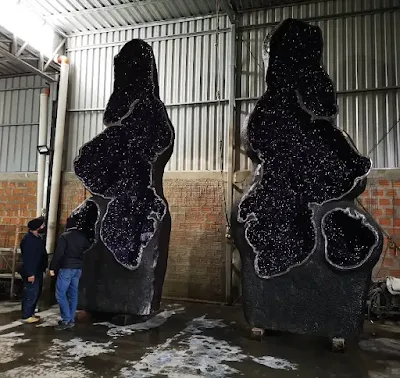The Giant Amethyst Geodes in Uruguay
The giant amethyst geodes in Uruguay are the largest in the world. Nestled in the Artigas department of Uruguay lie some of the most extraordinary geological wonders on Earth - giant amethyst geodes. These colossal formations, some reaching over 5 meters in height and weighing several tons, are not only visually stunning but also offer valuable insights into Earth's history and mineral formation processes.
They formed in the right conditions over a long period of time. Amethyst is a purple variety of quartz, the most popular gemstone in the quartz family. It is a semi-precious stone that is prized for its deep purple color.
Where are the Giant Geodes found
The giant amethyst geodes are predominantly found in the Artigas department, located in northwestern Uruguay, near the border with Brazil. This region sits atop the Artigas Formation, a volcanic rock formation rich in basaltic rock, the perfect host for geode formation.
How large are the Giant Geodes
Most geodes: Generally smaller, ranging from 0.3 meters (1ft) to 2 meters (6ft) in diameter.
Largest recorded: These truly are giants, reaching up to 7 meters (23ft) in diameter and weighing up to 30 tons.
Examples include:
- "The Empress of Uruguay": Weighs an estimated 2.5 tons and stands over 3 meters tall.
- "Enchanted Cave": Discovered in 2019, it weighs over 20,000 kg (44,000 lbs) and measures 5.5 meters (18ft) wide.
- Shandong Tianyu Museum Geode: While not located in Uruguay, it holds the Guinness World Record as the largest amethyst geode, weighing 13,000 kg (28,660 lbs) and measuring 3m x 1.8m x 2.2m.
How were the Giant Geodes formed
The giant amethyst geodes were formed over millions of years in a process called hydrothermal alteration. Hydrothermal alteration is a process that occurs when hot water and dissolved minerals circulate through rocks. The hot water dissolves minerals from the rocks and carries them away. When the water cools, the minerals precipitate out of solution and form new minerals.
In the case of the giant amethyst geodes, the hot water that circulated through the rocks was rich in silica and iron. When the water cooled, the silica and iron precipitated out of solution and formed amethyst crystals. The amethyst crystals grew over time, eventually forming the giant geodes that are found in Uruguay today.
 |
| Giant amethyst geodes Credit: Nowar Minerals, Inc. |
Why the amethyst geodes in Uruguay are very huge
The giant amethyst geodes in Uruguay are so huge because they formed in the right conditions. These conditions included:
- Abundant silica and iron: The hot water that circulated through the rocks was rich in silica and iron, which are the two main ingredients in amethyst.
- Suitable host rocks: The host rocks for the amethyst geodes were basalt, a type of volcanic rock. Basalt is porous and allows the hot water to circulate through it.
- Long periods of time: The amethyst crystals grew over millions of years. The larger the geode, the longer it took for the crystals to grow.
- A stable climate: The climate in Uruguay has been relatively stable for millions of years. This has allowed the amethyst crystals to grow undisturbed.
- A lack of erosion: The area where the giant amethyst geodes are found is relatively protected from erosion. This has helped to preserve the geodes over time.
The giant amethyst geodes in Uruguay are a rare and beautiful natural phenomenon. They are a testament to the power of nature and the beauty of the natural world. If you are ever in Uruguay, be sure to visit them. You won't be disappointed.
 |
| Amethyst geode from Artigas, Uruguay. Photo: Le Stage Minerals |
The largest amethyst geode in the world
 |
| The largest amethyst geode, Shandong Tianyu Museum of Natural History (China) 3mx1,8mx2,2m 13tonnes |
 |
| Amethyst geodes from Uruguay Photo: Le Stage Minerals |
The giant amethyst geodes of Uruguay stand as a testament to the Earth's geological processes and the stunning beauty that can emerge from nature's depths. These colossal formations continue to captivate both scientific minds and those with an appreciation for the natural wonders found within the Earth's crust.
See also: Amethyst Stalactites - A Rare and Mysterious Formation

%20(1).webp)






